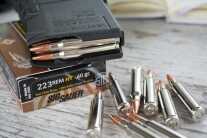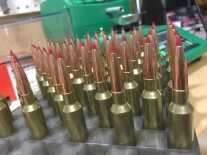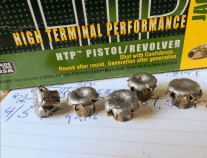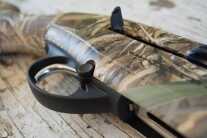Crimping gets a bad rap. Just as we sometimes tend to fix construction mistakes with a hammer rather than taking the time to properly fit parts, we tend to view crimping as a way to “fix” a less than perfect bullet seating. The problem with crimping is that it sounds so logical. The word “crimping” kind of implies the process of locking a bullet in place. But, there is more to it than just that.
Tom McHale
Show First
Ammo Test: Sig Sauer HT: .308 Winchester, 300 Blackout, and .223 Remington
Published: May 10, 2017 { 11 comments }We’re going to test out three new hunting loads from Sig Sauer Elite Performance Ammunition, and in the process, tell you how you can win a year’s worth of Sig Sauer ammo. Read on.
A Recoilless Snubbie .357? The 7-Shot Smith & Wesson Performance Center 586 L-Comp – Full Review
Published: April 4, 2017 { 47 comments }How would you feel about shooting a .357 Magnum revolver with virtually no muzzle flip? That’s exactly what the Smith & Wesson 586 L-Comp is all about. Let’s take a closer look.
Reloading: Seating and Crimping Bullets
Published: March 31, 2017 { 13 comments }So, let’s discuss the topic of seating and crimping in the reloading process. Stated simply, the seating step simply means jamming a new bullet into a cleaned, resized, primed, and powder-charged cartridge case. Crimping “generally” refers to the act of bringing the neck of the cartridge case back to proper dimension after that bullet is stuffed in. There’s a lot more to both actions, especially if you want to be safe, so let’s take a closer look at both steps.
Ammo Test: The HTP Hammer – Remington’s Affordable 9mm JHP
Published: March 31, 2017 { 13 comments }Premium self-defense ammo can cost over a buck a round. With this in mind, we decided to run Remington’s HTP 9mm through the wringer. Going price is about $23 per box. However, that’s a box of 50 rounds, not the usual 20 for most self-defense ammo. That works out to about 45 or so cents a round, less than half the price of other self-defense ammo.
Bird of Another Feather: Beretta’s A350 Xtrema Max5 12 Ga. 3.5″ Waterfowler – Full Review.
Published: March 30, 2017 { 2 comments }When my editor gave me the opportunity to try out the new A350 XTrema Max5 from Beretta, I was happy to oblige. The last Beretta shotgun I looked at here was a prima donna – the Beretta 692 Sporting B-Fast over and under. While that one was certainly made to shoot and admire, I might have a little heartburn tossing it into a John boat in the middle of January. This 3.5-inch, 12 gauge A350 Xtrema Max5 model is all about maintaining a working gun reputation, but that doesn’t mean it skimps on classic Beretta features.
Ammo Test: Liberty Ammunition Civil Defense 9mm and .45 ACP
Published: March 21, 2017 { 23 comments }Taking the idea of “light and fast” model to new levels, the Civil Defense projectiles weigh in at well under half that same caliber traditional bullets. For example, the 9mm projectile weighs just 50 grains. Compare that to 115 or 124 grains for common 9mm defense rounds. The .45 ACP bullets weigh in at 78 grains as compared to a more traditional weight range of 185 to 230 grains. The result is blistering speed.
A Ton Of Rifle For Your Money: Thompson/Center .308 Compass – Full Review
Published: March 6, 2017 { 42 comments }The Compass rifle from Thompson/Center offers shooters a sub-MOA capable rifle ready for the hunting fields at an amazing MSRP of only $399.
Ammo Test: Winchester PDX1 Defender Segmenting Slug
Published: March 1, 2017 { 8 comments }What do you do if you don’t feel that a 12-gauge slug doesn’t have enough stopping power? OK, so maybe if you ever feel under gunned with a shottie slug you’re fighting Godzilla, but, hey, it could happen. You could try to stuff a 40mm grenade in there, but that requires all sorts of complicated licensing. A more realistic option might be to use a fragmenting projectile design. That’s exactly what Winchester Ammunition has done with their PDX1 Defender Segmenting Slug.
Reloading: Bullet Materials and Shapes
Published: February 3, 2017 { 13 comments }Bullets are bullets, right? Well, not really. There are a wide array of variables in bullet shape, weight, materials, and construction. Each of these variables can have a dramatic impact on the performance, and safety, of any given load. In other words, loading recipe data for one 147-grain, .308 bullet may be incorrect, and even unsafe, for another projectile of equal caliber and weight. Let’s take a closer look at some of the variables and what you need to know about each.










